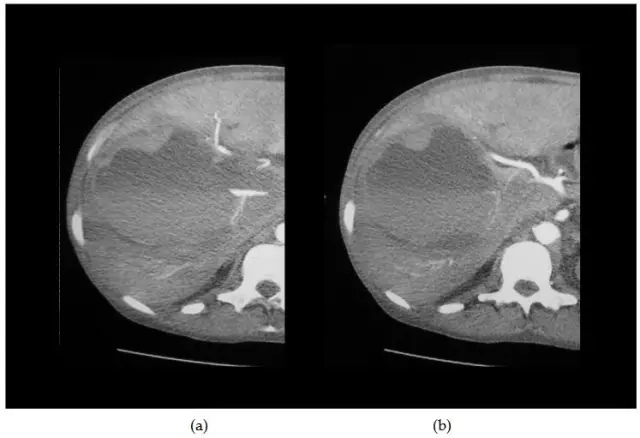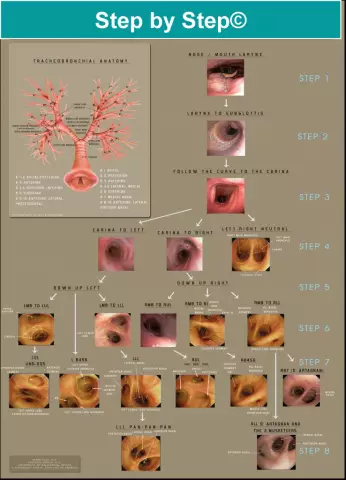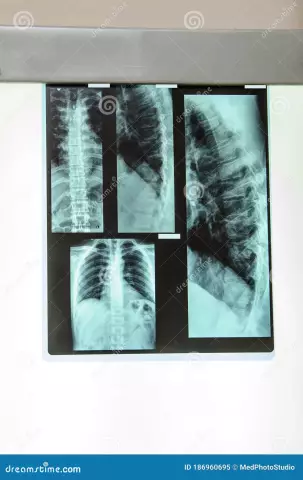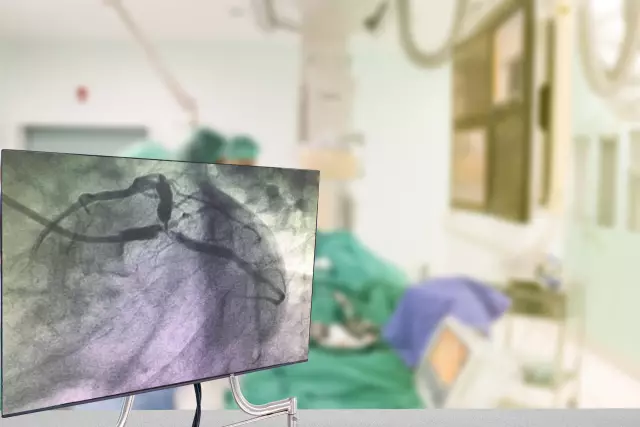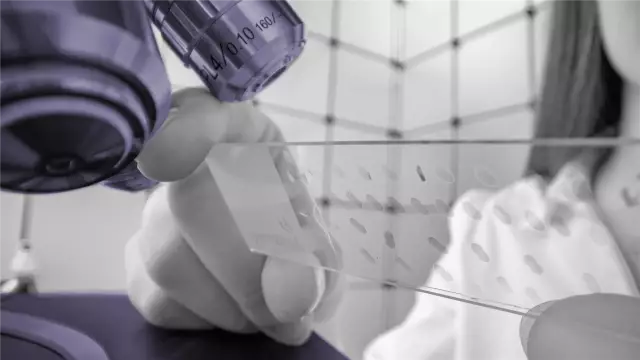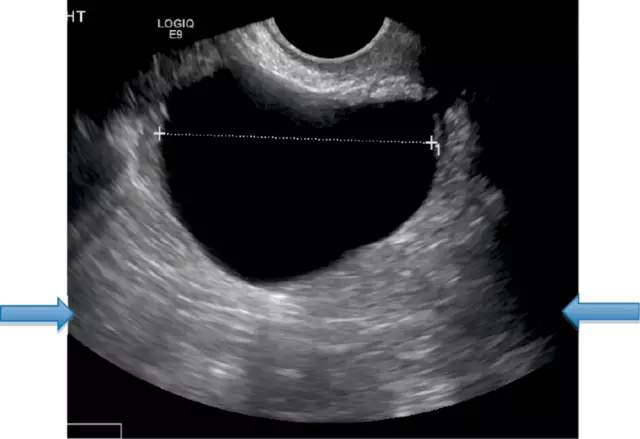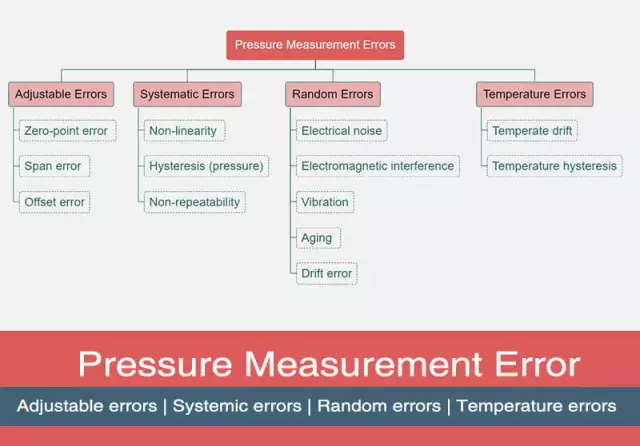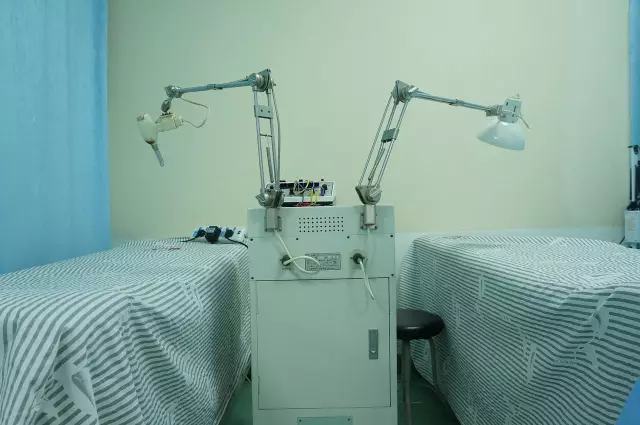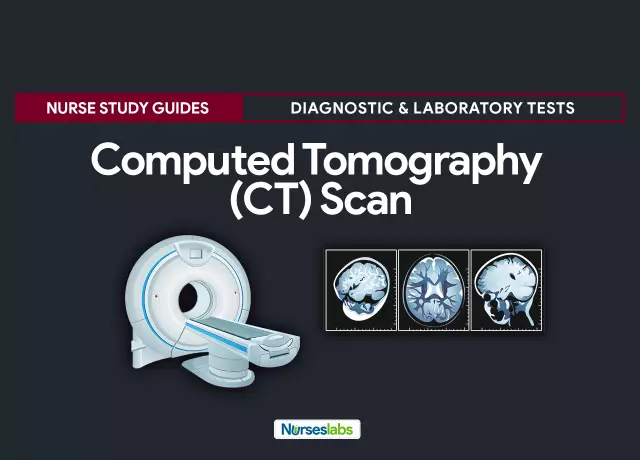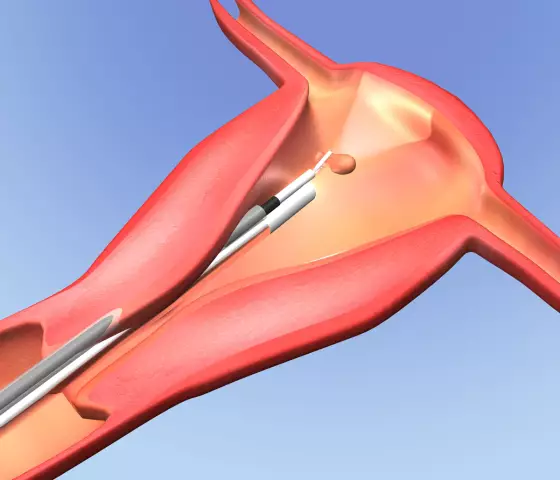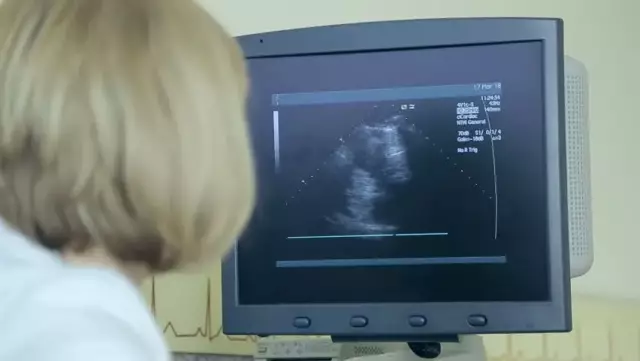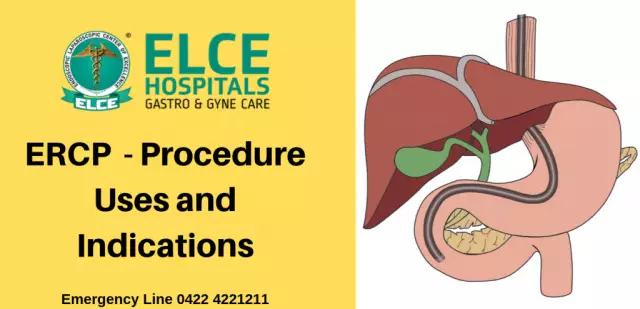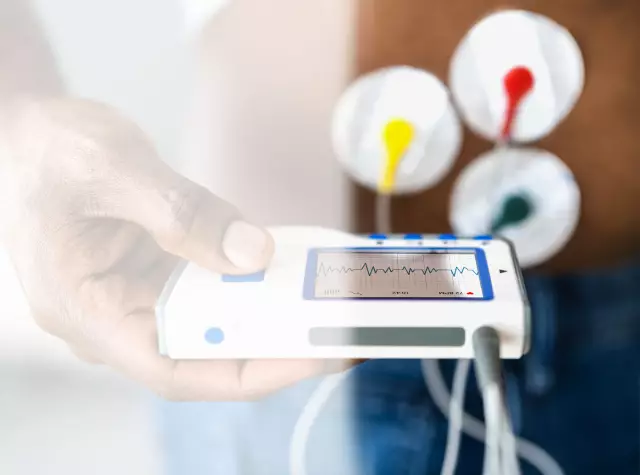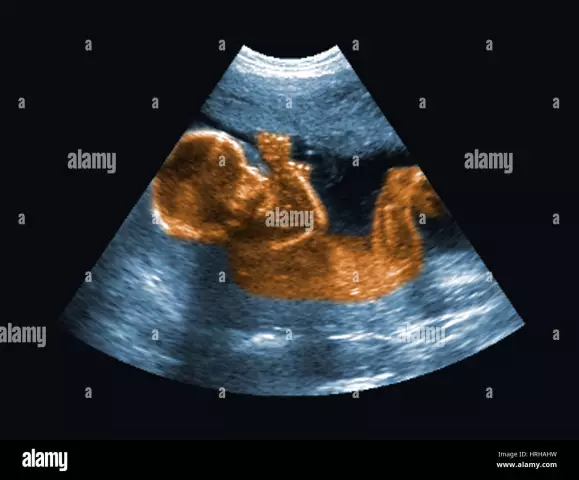Diagnostic methods
Last modified: 2025-11-02 20:11
Liver biopsy is a medical procedure in which a doctor inserts a special needle into the liver and takes material for tests and diagnostics of the organ's condition
Last modified: 2025-11-02 20:11
Allergic tests, which are divided into skin and provocative tests, are carried out in order to identify an allergic disease in a person. This study allows you to assess the development and nature of the inflammatory response
Last modified: 2025-11-02 20:11
Electroencephalography is a diagnostic method used to study the functioning of the brain, based on the registration of its electrical potentials. This method is prescribed for neurotic, emotional, mental disorders, for inflammatory diseases of the nervous system, for craniocerebral trauma
Last modified: 2025-11-02 20:11
Bronchoscopy is a method for diagnosing the condition of the mucous membrane of the trachea and bronchi. It is carried out using a special flexible device - a broncho-fibroscope, which is inserted into the lumen of the trachea and bronchi
Last modified: 2025-11-02 20:11
X-ray is a medical diagnostic study of human internal organs using X-rays, followed by their projection onto a special film or photographic paper
Last modified: 2025-11-02 20:11
Angiography is an X-ray examination of blood vessels, with the help of which defects in their development, impaired patency, possible damage (aneurysms, narrowing, malformations), benign and malignant formations are detected
Last modified: 2025-11-02 20:11
FGDS (fibrogastroduodenoscopy) - a type of endoscopic examination of the upper gastrointestinal tract
Last modified: 2025-11-02 20:11
An enzyme immunoassay is performed to diagnose viral diseases at an early stage, when other diagnostic methods are powerless. This analysis also reveals a predisposition to certain hereditary diseases
Last modified: 2025-11-02 20:11
Colonoscopy - allows you to examine the condition of the walls of the colon, without surgery. This method can detect the presence or absence of many bowel diseases, including colon cancer
Last modified: 2025-11-02 20:11
Sigmoidoscopy is a diagnostic method in which the mucous membrane of the rectum and sigmoid colon is examined. The examination is carried out with a special apparatus - a sigmoidoscope, made in the form of tubes with lenses, and a lighting device
Last modified: 2025-11-02 20:11
Rheography is a non-invasive diagnostic method in which the blood supply to individual organs and the whole organism is examined. Rheography is based on the principle of registering changes in tissue electrical resistance associated with changing blood volume. Research is carried out using a special device - rheograph
Last modified: 2025-11-02 20:11
A biopsy is done to examine thyroid cells for nodules that have formed. Thyroid biopsy is indicated for patients with indirect symptoms of malignancy, i.e. examining nodes larger than 1 cm
Last modified: 2025-11-02 20:11
Ultrasound of the uterus is a safe and effective method for diagnosing the condition of the uterus and appendages in women. It allows you to consider the shape of the uterus, its structure and size, diagnose the presence or absence of certain formations of a different nature, identify gynecological diseases, draw a conclusion about the cause of infertility
Last modified: 2025-11-02 20:11
Ultrasound of the mammary glands is a method of examining the breast, carried out to diagnose volumetric neoplasms detected by palpation. Ultrasound of the mammary glands is a harmless procedure for the female body, therefore there are no contraindications to its conduct
Last modified: 2025-11-02 20:11
Irrigoscopy is currently the safest method for examining the large intestine. Irrigoscopy is performed using X-rays and can reveal a number of diseases: ulcerative colitis, bowel cancer, polyps
Last modified: 2025-11-02 20:11
Peak flowmetry is a diagnostic method in which the peak velocity of exhaled air is measured using a special device - a peak flow meter. This diagnostic method is used to monitor lung function in chronic obstructive pulmonary disease and bronchial asthma
Last modified: 2025-11-02 20:11
Colposcopy is a study of the walls of the cervix, carried out using a special microscope - a colposcope. Colposcopy is used to detect and diagnose many diseases, including: genital warts, cancer of the vagina and cervix, various benign neoplasms
Last modified: 2025-11-02 20:11
Coronary angiography is an X-ray method for examining the vessels of the heart. With its help, the lesions and their degree are revealed. Prescribed to clarify the diagnosis for chest pain, heart failure, heart attack, suspected coronary heart disease
Last modified: 2025-11-02 20:11
Prenatal diagnostics is a set of measures taken to examine the fetus during pregnancy. Its main purpose is to identify hereditary diseases and various pathologies of the child's development
Last modified: 2025-11-02 20:11
Genetic analysis is a collection of various clinical studies and experiments aimed at studying the properties of genes and determining hereditary traits. The main types of genetic analysis are genetic compatibility analysis, analysis for genetic diseases and genetic analysis during pregnancy
Last modified: 2025-11-02 20:11
Fluorography of the lungs is a diagnostic study of the chest organs, carried out no more than once a year, if an additional examination is not required. The data obtained with the help of fluorography can reveal many diseases of the lungs
Last modified: 2025-11-02 20:11
Measuring blood pressure is a diagnostic method used by doctors to determine the level of blood pressure in the body. To measure pressure, a special apparatus is used - a tonometer, which can be mechanical or automatic
Last modified: 2025-11-02 20:11
A prostate biopsy is a medical procedure in which a piece of the prostate gland is taken from a patient for cytological and histological analysis. A biopsy is done to confirm prostate cancer
Last modified: 2025-11-02 20:11
Urography is a diagnostic procedure performed to examine the condition of the kidneys. Urography is prescribed if there is blood in the urine or if kidney stones are suspected. Urography is performed using X-ray and contrast fluid
Last modified: 2025-11-02 20:11
Spine tomography is the most informative and reliable type of examination of the spine and adjacent tissues. This diagnostic method does not require instrumental intervention in the body, and is considered one of the most effective and safe
Last modified: 2025-11-02 20:11
Amniocentesis is a diagnostic method used in prenatal medicine to examine the amniotic fluid during pregnancy. The amniocentesis procedure involves the doctor puncturing the abdominal wall of the uterus and removing a small amount of amniotic fluid
Last modified: 2025-11-02 20:11
Duodenal intubation is a diagnostic procedure in which a rubber probe with holes is inserted into the duodenum to sample a mixture of bile with intestinal and gastric juice
Last modified: 2025-11-02 20:11
Abdominal tomography is a diagnostic method with which you can get detailed information about the state of organs located in the abdominal cavity: kidneys, liver, adrenal glands, spleen, vessels. Abdominal tomography is successfully used to diagnose various diseases, including oncological
Last modified: 2025-11-02 20:11
Lung tomography is a method for examining the state of the lungs and diagnosing their diseases. With the help of tomography, diseases such as tuberculosis, lung cancer, pneumonia can be detected. A tomography is performed using an X-ray ring that can take pictures from different angles
Ultrasound Of The Kidneys - Indications, Preparation For The Procedure, How The Study Is Carried Out
Last modified: 2025-11-02 20:11
Kidney ultrasound is a method for diagnosing diseases of the kidneys and urinary system. It can help determine the location, shape and size of the kidneys and bladder. This research method is very effective, but at the same time completely safe for the body
Last modified: 2025-11-02 20:11
Ultrasound of internal organs is a method for diagnosing organs located in the abdominal cavity. It can be used to determine the presence or absence of neoplasms, traumatic injuries and inflammatory changes in internal organs
Last modified: 2025-11-02 20:11
Spermogram - an analysis of a man's ability to conceive. A deviation of the spermogram from the norm is an indicator of a decrease in a man's ability to conceive
Last modified: 2025-11-02 20:11
Hysteroscopy is a diagnostic procedure performed using a special endoscopic device to examine the uterine cavity. Hysteroscopy allows you to take a biopsy of the material and accurately establish the diagnosis
Last modified: 2025-11-02 20:11
Transvaginal ultrasound is a diagnostic method used to examine the pelvic organs. This method is carried out using a special ultrasound vaginal sensor, and is able to identify various urological and gynecological diseases
Last modified: 2025-11-02 20:11
Gastroscopy is a diagnostic procedure performed for endoscopic examination of the upper gastrointestinal tract. To do this, use a special instrument - a gastroscope, inserted into the stomach through the mouth and esophagus
Last modified: 2025-11-02 20:11
Urinalysis is a laboratory test carried out to detect various diseases. A urine test allows the doctor to assess the general condition of the body, identify the risk of developing various pathologies and, if necessary, prescribe appropriate treatment
Last modified: 2025-11-02 20:11
Holter monitoring is a method of functional diagnostics, with the help of which daily monitoring of the electrocardiogram is carried out
Last modified: 2025-11-02 20:11
Ultrasound of the heart is a diagnostic procedure carried out to study the work of the heart and identify various diseases and pathologies. Ultrasound of the heart is an absolutely safe research method, therefore it is possible to carry out it in newborns and during pregnancy
Last modified: 2025-11-02 20:11
Brain tomography is the main way to study the internal structure of the brain and its vessels. With its help, you can diagnose the presence of diseases and changes in the brain. Brain tomography can be performed using various methods, which differ in the results obtained
Last modified: 2025-11-02 20:11
Fetal ultrasound is the main method used in medicine to diagnose fetal development during pregnancy. The objectives of such a study may differ and depend on the duration of pregnancy

